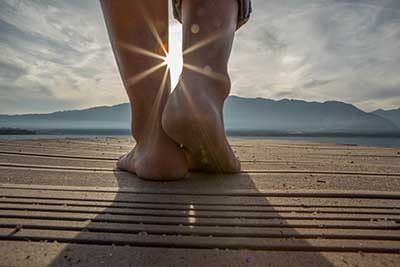Corns and Calluses Treatment in Las Colinas, TX

Corns and calluses are hardened area of skin that develop due to consistent pressure or irritation. The primary difference between calluses and corns is that foot corns typically develop on top of your feet or in between toes, while foot calluses typically develop on the bottoms of feet.
The inner core of a corn can be either thick or soft. If it is on the top of your toes, it is typically hard. If it is in between your toes, it is typically soft.
Since corns and calluses are not caused by a virus or bacteria, they're not contagious. However, they can sometimes be painful and, for diabetics, they can potentially lead to complications. Diabetics should have their feet checked regularly by a podiatrist.
Corns and Calluses Causes
The most common causes for corns are:
- Shoes that do not fit right, rub and/or cause irritation or pressure on toes
- Hereditary (due to bunions and hammer, claw or mallet toes)
- Rheumatoid arthritis
Calluses are fairly common and can have a number of causes. They can be the result of:
- Shoes that don't fit right and rub or are too tight
- Wearing shoes without socks, or socks that are too tight
- Women who frequently wear high heels
- Hereditary (due to bunions and hammer, claw or mallet toes)
- Bone structure issues
- Playing sports
Corns and Calluses Symptoms
The most common symptoms of hard corns are:
- Hard and thick raised bumps, rounded or in the shape of a cone
- Dry, scaly or flaky skin
- Tenderness and pain under skin
- Foot pain and difficulty walking
The most common symptoms of soft corns are:
- May look like an open sore and is usually in between fourth and fifth (pinky) toe
- Bumps are often whitish and messy
- Pain and difficulty walking
The most common symptoms of calluses are:
- Hard, dry and/or thick skin or soft tissue
- May be grayish or yellowish
- Has very little or no feeling
- May be bumpy
- Usually develop on soles of feet, balls of feet, heels, palms or fingertips
Corns and Calluses Treatment
Most of the time, corns and calluses can be treated with topical over-the-counter remedies. The most effective topical ointments will have an active ingredient called salicylic acid, which dissolves the excess protein in corns and calluses and helps to shrink them.
For natural remedies, try applying germ oil, castor oil, sesame seed oil or olive oil to the affected areas. Another option is soaking your feet in warm water and baking soda.
If your corns or calluses are causing pain or you are a diabetic and choose to visit a healthcare provider, your healthcare provider will typically want to physically examine your feet, and may choose to do an X-ray to check for bone or hereditary issues. Your healthcare provider may choose to offer a prescription in severe cases to help with your pain and discomfort.
Request more information about corns and calluses today. Call (817) 203-2760 or contact Ms. Jessica Stangenwald online.
The New You Medical & Infusion Clinic
Address
100 Grapevine HwyHurst, TX 76054
(817) 203-2760
https://www.newyoumedclinic.com/
Hours
Mon:
10:00 am - 6:00 pm
Tue:
10:00 am - 6:00 pm
Wed:
10:00 am - 6:00 pm
Thu:
10:00 am - 6:00 pm
Fri:
Closed
Sat:
Closed
Sun:
Closed


